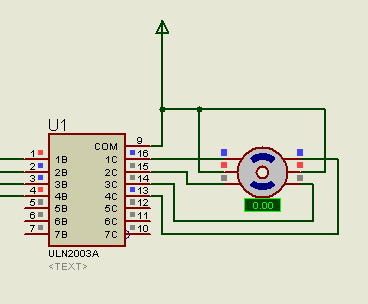►Programming Full step Sequence
►C Programming
I am assuming that stepper motor is connected at Port 1.0 to Port 1.3. Adjusting the delay will increase or decrease the speed of the motor. Here just for demonstration i have taken some delay, you can change it as you want.
[Tip: Do testing.. ]
]
►Assembly Programming
The working of the above code can be seen in the demo animation below.

►C Programming
I am assuming that stepper motor is connected at Port 1.0 to Port 1.3. Adjusting the delay will increase or decrease the speed of the motor. Here just for demonstration i have taken some delay, you can change it as you want.
[Tip: Do testing..
 ]
]
CODE:
#include <REG2051.H>.
#define stepper P1
void delay();
void main(){
while(1){
stepper = 0x0C;
delay();
stepper = 0x06;
delay();
stepper = 0x03;
delay();
stepper = 0x09;
delay();
}
}
void delay(){
unsigned char i,j,k;
for(i=0;i<6;i++)
for(j=0;j<255;j++)
for(k=0;k<255;k++);
}
#define stepper P1
void delay();
void main(){
while(1){
stepper = 0x0C;
delay();
stepper = 0x06;
delay();
stepper = 0x03;
delay();
stepper = 0x09;
delay();
}
}
void delay(){
unsigned char i,j,k;
for(i=0;i<6;i++)
for(j=0;j<255;j++)
for(k=0;k<255;k++);
}
►Assembly Programming
CODE:
org 0H
stepper equ P1
main:
mov stepper, #0CH
acall delay
mov stepper, #06H
acall delay
mov stepper, #03H
acall delay
mov stepper, #09H
acall delay
sjmp main
delay:
mov r7,#4
wait2:
mov r6,#0FFH
wait1:
mov r5,#0FFH
wait:
djnz r5,wait
djnz r6,wait1
djnz r7,wait2
ret
end
stepper equ P1
main:
mov stepper, #0CH
acall delay
mov stepper, #06H
acall delay
mov stepper, #03H
acall delay
mov stepper, #09H
acall delay
sjmp main
delay:
mov r7,#4
wait2:
mov r6,#0FFH
wait1:
mov r5,#0FFH
wait:
djnz r5,wait
djnz r6,wait1
djnz r7,wait2
ret
end
The working of the above code can be seen in the demo animation below.

No comments:
Post a Comment